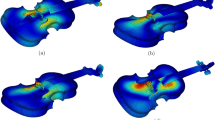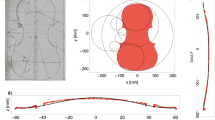The material used by the old masters to make exquisite violins may have been chemically manipulated.
Abstract
Whether or not the great Italian violin-makers used wood that had been chemically processed in order to preserve it and enhance the instrument's sound quality has long been a contentious issue1,2. Here we use nuclear magnetic resonance and infrared spectroscopy to analyse organic matter in wood taken from antique instruments made by Stradivari and Guarneri del Gesu. Our results indicate that the wood used by the masters could indeed have been chemically treated, a technique that may inspire an approach to violin making that is more chemistry-based.
This is a preview of subscription content, access via your institution
Access options
Subscribe to this journal
Receive 51 print issues and online access
199,00 € per year
only 3,90 € per issue
Buy this article
- Purchase on SpringerLink
- Instant access to full article PDF
Prices may be subject to local taxes which are calculated during checkout

Similar content being viewed by others
References
Gough, C. Phys. World http://physicsweb.org/articles/world/13/4/8 (April 2000).
Nagyvary, J. Edu. Chem. 42, 96–98 (2005).
Kolodziejski, W., Frye, J. S. & Maciel, G. E. Anal. Chem. 54, 1419–1424 (1982).
Kosikova, B., Hricovini, M. & Cosentino, C. Wood Sci. Technol. 33, 373–380 (1999).
Orton, C. R., Parkinson, D. Y., Evans, P. D. & Owen, N. L. Appl. Spectrosc. 58, 1265–1271 (2004).
Anderson, E. L., Pawlak, Z., Owen, N. L. & Feist, W. C. Appl. Spectrosc. 45, 641–647 (1991).
Sacconi, S. F. I “Segreti” di Stradivari (Libreria del Convegno, Cremona, 1972).
Haines, D. W. Catgut Acoust. Soc. Newslett. 33, 19–23 (1980).
Author information
Authors and Affiliations
Corresponding author
Ethics declarations
Competing interests
The authors declare no competing financial interests.
Supplementary information
Supplementary Methods
This file describes the method of sample preparation and the conditions of the NMR and FTIR spectroscopies. It also includes the method of statistical analysis of the IR spectra. (PDF 18 kb)
Supplementary Figure Legends
This file identifies the curves in the four SI figures. (PDF 6 kb)
Supplementary Discussion
A summary of the SI materials and conclusions. (PDF 8 kb)
Supplementary Figure 1
Solid state NMR spectra of 5 maple wood samples. Assignments are provided in the figure as Stradivarius cello, Bosnian K-silicate treated, the Jay viola, the Gand-Bernardel violin, and boiled-baked Bosnian maple. (PDF 66 kb)
Supplementary Figure 2
FTIR spectra of 3 maple wood samples. Assignments are provided in the figure as the Stradivarius cello, the boiled-baked Bosnian maple and the Ksilicate treated maple. (PDF 93 kb)
Supplementary Figure 3
FTIR spectra of samples from the Jay viola and the Gand-Bernardel violin. Assignments given in the figure. (PDF 78 kb)
Supplementary Figure 4
FTIR spectra of maple heartwood and sapwood samples. The source was a 30-year old European tone wood. Assignments provided in the figure. (PDF 78 kb)
Rights and permissions
About this article
Cite this article
Nagyvary, J., DiVerdi, J., Owen, N. et al. Wood used by Stradivari and Guarneri. Nature 444, 565 (2006). https://doi.org/10.1038/444565a
Received:
Accepted:
Published:
Issue Date:
DOI: https://doi.org/10.1038/444565a
This article is cited by
-
Science can tell us only so much about Stradivarius violins
Nature (2017)
-
Shellac/nanoparticles dispersions as protective materials for wood
Applied Physics A (2016)
-
Physisporinus vitreus: a versatile white rot fungus for engineering value-added wood products
Applied Microbiology and Biotechnology (2011)
-
Rot offers fresh sound for violin makers
Nature (2008)
-
Old violins reveal their secrets
Nature (2008)



